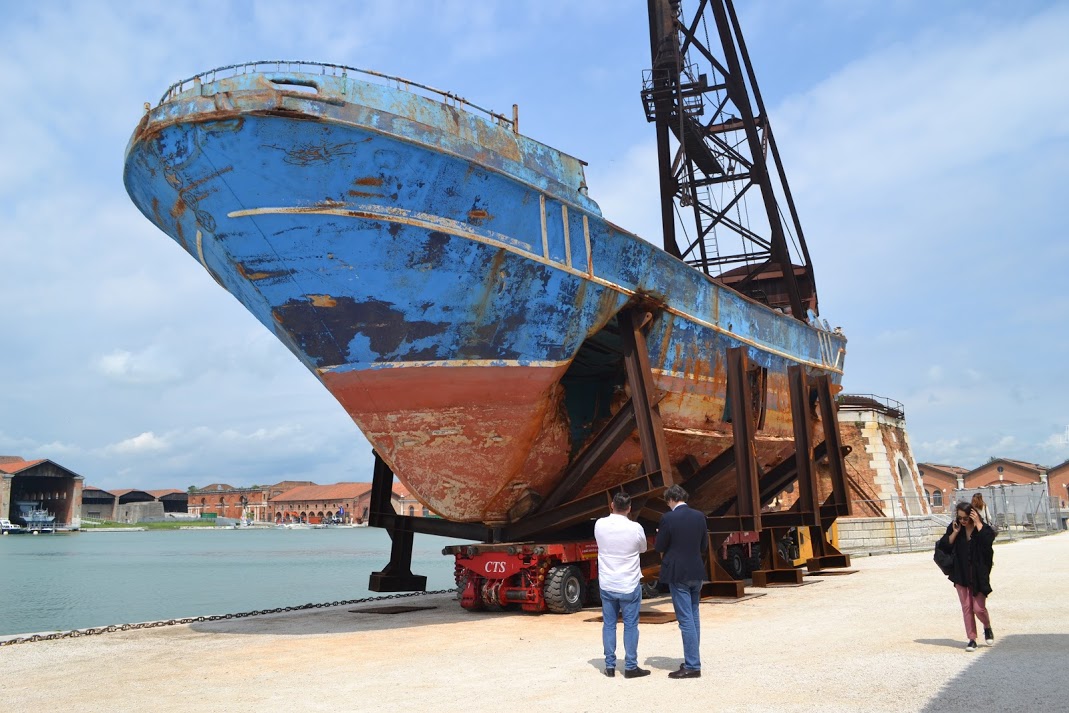[ad_1]
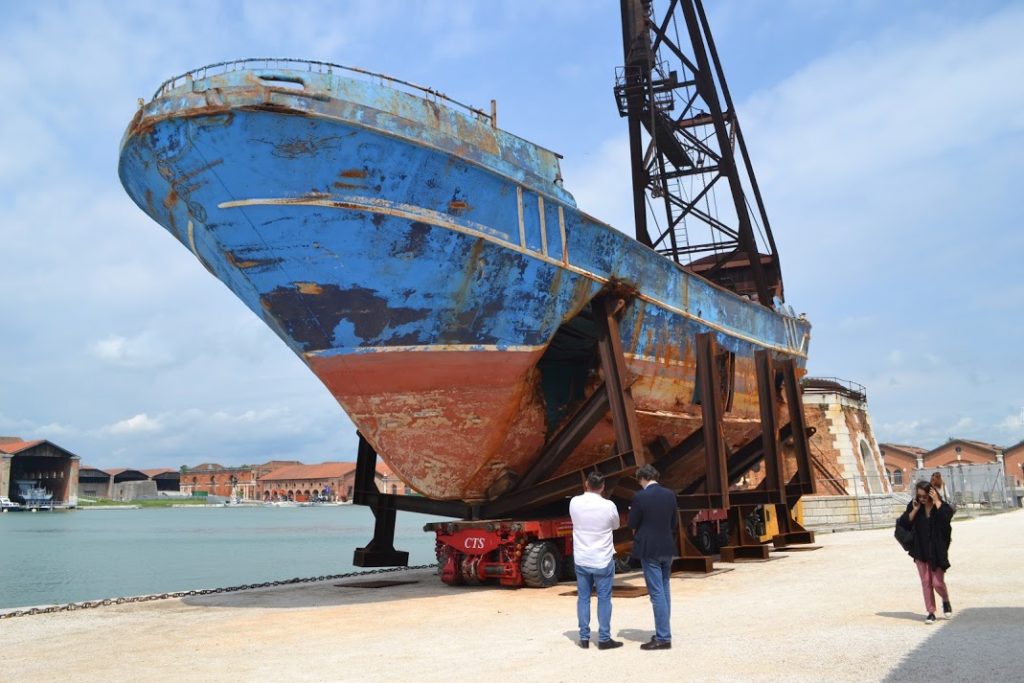
A fishing boat that sank in the Mediterranean Sea in 2015, killing most of the more than 800 estimated people aboard. It is on view at the Venice Biennale in a project by Christoph Büchel.
PHOTOS: ANDREW RUSSETH, EXCEPT WHERE NOTED
The defining display at the 58th Venice Biennale is not an artwork. It is a fishing boat, with huge gashes in its hull, that is now stationed in the Arsenale, the old dockyards of the Venetian Republic. Designed to carry about 15 passengers, it sank in the Mediterranean Sea in April 2015, with more than 800 migrants who had left from Tripoli, Libya. All but 27 died. The artist Christoph Büchel has brought the vessel here in a project called “Barca Nostra” (Our Boat). It rests on a metal frame next to a café with no signage or explanation.
What can one possibly say about what is essentially an empty mass grave? It is the last thing that hundreds of people—adults and children—touched before drowning. It is much smaller than the luxurious yachts docked alongside the Giardini about a mile away. Its presence feels at once obscene and essential at the most closely watched art exhibition in the world. And it marks just one of the crises now transpiring elsewhere around the globe.
After the close of the Biennale, in November, the ship will return to Augusta in Sicily, where it has been stored since being recovered, and eventually a memorial for the tragedy will be built. Great monuments invite viewers to reflect on their ideals, and to measure their actions against them. They are, in some sense, tests. In a year that has seen more than 400 migrants die in the Mediterranean, and the American president laugh about shooting asylum-seekers along the U.S.–Mexico border, the test presented by that future memorial is one that we are now failing.
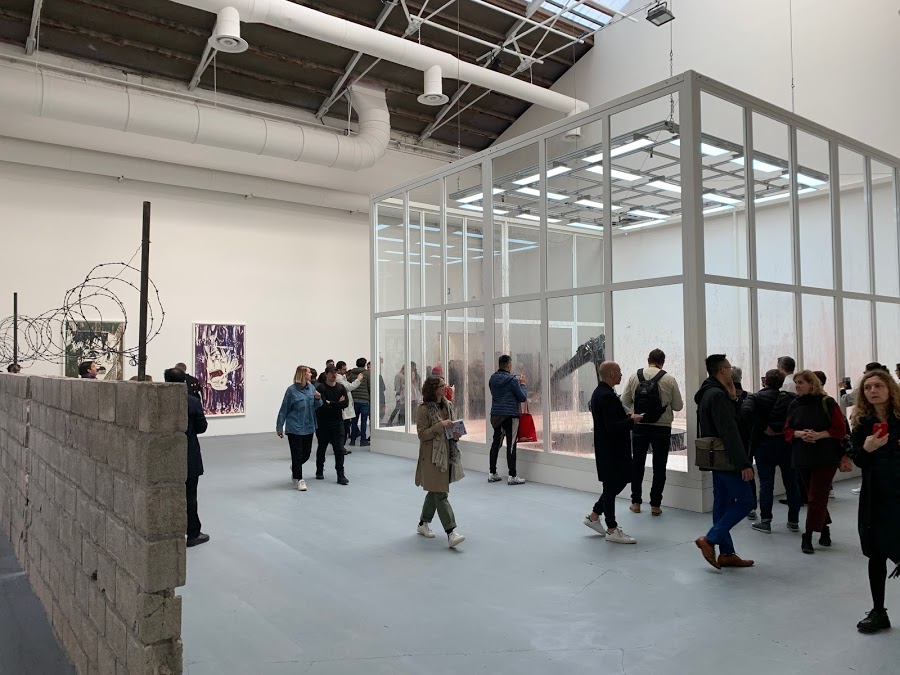
An installation view of the 58th Venice Biennale’s main show, “May You Live in Interesting Times,” in the Central Pavilion in the Giardini. At left, Teresa Margolles’s Mura Cuidad Juárez, 2010; at right, Sun Yuan and Peng You’s Can’t Help Myself, 2016. Pieces by Christian Marclay are on the back wall.
The boat is the most direct—some might say appallingly so—invocation of the contradictions of the present moment in the Biennale’s main exhibition, “May You Live in Interesting Times.” The show’s curator, Ralph Rugoff, who runs the Hayward Gallery in London, has eschewed a unifying thesis, but in fact his show of roughly 80 artists and teams feels remarkably coherent in its themes, which include a heavy emphasis on trauma.
All hell is breaking loose in the show. In the half of it on view in the Arsenale, two monstrous figures greet visitors in George Condo’s Double Elvis (2019) as explosions and gunshots spill out of a room hosting Christian Marclay’s 48 War Movies (2019). These films of combat are nested one inside the other, in concentric rectangles, and they loop in an illegible, cacophonous haze. The effect is transfixing, but it quickly wears you down.
[See more images from the Giardini section of the Venice Biennale.]
In the show’s other half, situated in the Giardini’s Central Pavilion, the skylight in its grand dome has been blacked out, cloaking the soaring room it covers in darkness. A projection of a menacing demon by Cyprien Gaillard glows at its center, surrounded by the deformed concrete bodies of Yu Ji and works by Danh Vo that include huge mirror-surface paintings that Peter Bonde has splashed with paint. The Enlightenment is giving way to the Middle Ages.
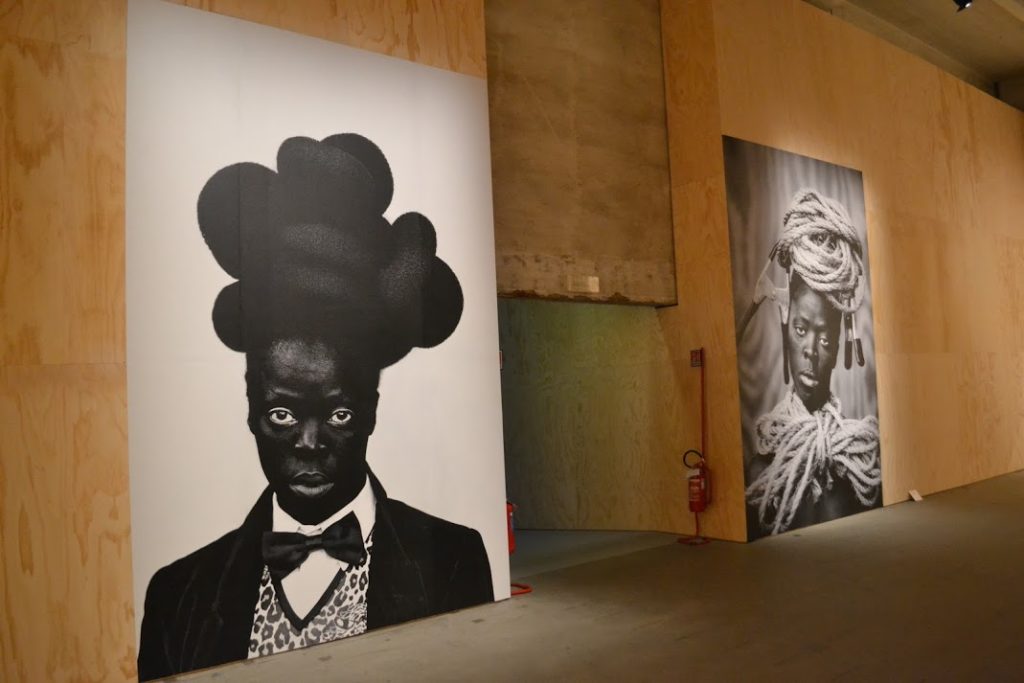
Photographs by Zanele Muholi in the Arsenale section of the 58th Venice Biennale’s main show, “May You Live in Interesting Times.” Ralph Rugoff, the show’s curator has divided his exhibition into two parts—“Proposition A” in the Arsenale and “Proposition B” in the Giardini. Almost ever artist appears in both, usually with a different kind of work.
Walls are everywhere. Rula Halawani has shot black-and-white photos along tall ones built by Israel around Palestinian areas; Teresa Margolles has transported long rows of cinderblocks from Juárez, Mexico, topped with barbed wire and speckled with bullets; voice actors in a video by Lawrence Abu Hamdan invoke interviews with survivors of Syria’s Saydnaya prison, discussing how sound travels through the building; and a motorized metal gate by Shilpa Gupta slams against its wall every minute or so, plaster and paint falling to the ground.
Some of the work is painfully literal or obvious or uninteresting—like Gupta’s fence, Nabuqi’s giant faux billboard for a tropical vacation, and Gabriel Rico’s bland assemblages. But Rugoff deserves curatorial credit for keeping to a minimum the kind of text-heavy conceptual work that tends to dominate such grand exhibitions. His exhibition is weirdly uneven—the Arsenale is elegantly installed and judiciously paced‚ while the Central Pavilion in the Giardini is jam-packed and jumbled, doing a disservice to many works—but the show overall resounds with astonishing visual moments.
[See more images from the Arsenale section of the Venice Biennale.]
In superb, slick new Ed Atkins videos, a baby and a monk are in tears, and bodies are falling from the sky, piling up atop a hamburger bun. Jon Rafman has blue PowerPoint-style cartoon people tumbling through a landscape that resembles bruised skin and being pushed about by machines like widgets in a factory. Sun Yuan and Peng Yu offer a giant robot brush that sweeps around a blood-red liquid, splattering it about.
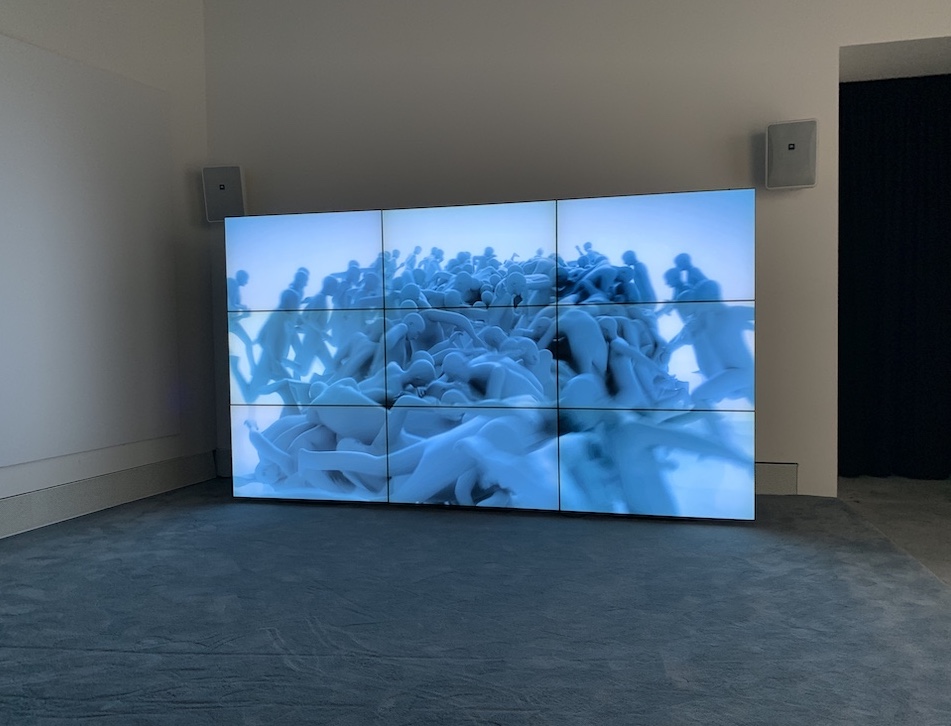
Jon Rafman, Disasters Under the Sea (still), 2019.
Elsewhere, mercifully, such in-your-face efforts are balanced by artists with more nuanced aims, like preserving histories, whether on a grand or a personal scale, in tones that range from optimistic to elegiac. Njideka Akunyili Crosby is showing jaw-dropping new portraits of herself and her family (she also has an excellent show of work at Victoria Miro gallery in Venice), and Henry Taylor has painted scenes of life in modern America: a white business executive being hauled off in handcuffs, a group of black women watching the funeral of a victim of the bombing of the 16th Baptist Church in Birmingham, Alabama, in 1963.
This is a very American Biennale (almost a third of the artists work in the U.S.), and our country’s enduring racism is a central issue. Arthur Jafa’s White Album charts the fears of white Americans around race in a series of found video monologues, while Kahlil Joseph’s BLK NWS intercuts more videos, music, and interviews with black art luminaries to create narratives of black life. They’re two of the Biennale’s best works. (The strong presence of black American artists is complemented by an essential exhibition of the legendary AfriCOBRA group outside of the Biennale at Ca’ Faccanon, a grand Venetian palazzo.)
Amid nods to the political nihilism, violence, and homogenizing corporate power of today, the Biennale evinces a commitment to an old-fashioned sensibility: that freedom comes down to self-presentation and being able to be oneself in public. Martine Gutierrez, a Latinx trans woman, shows herself in Helmut Newton-like fashion fantasias, and Mari Katayama frames her image in elaborate photographic tableaux that include prosthetic body parts and present her amputated legs.
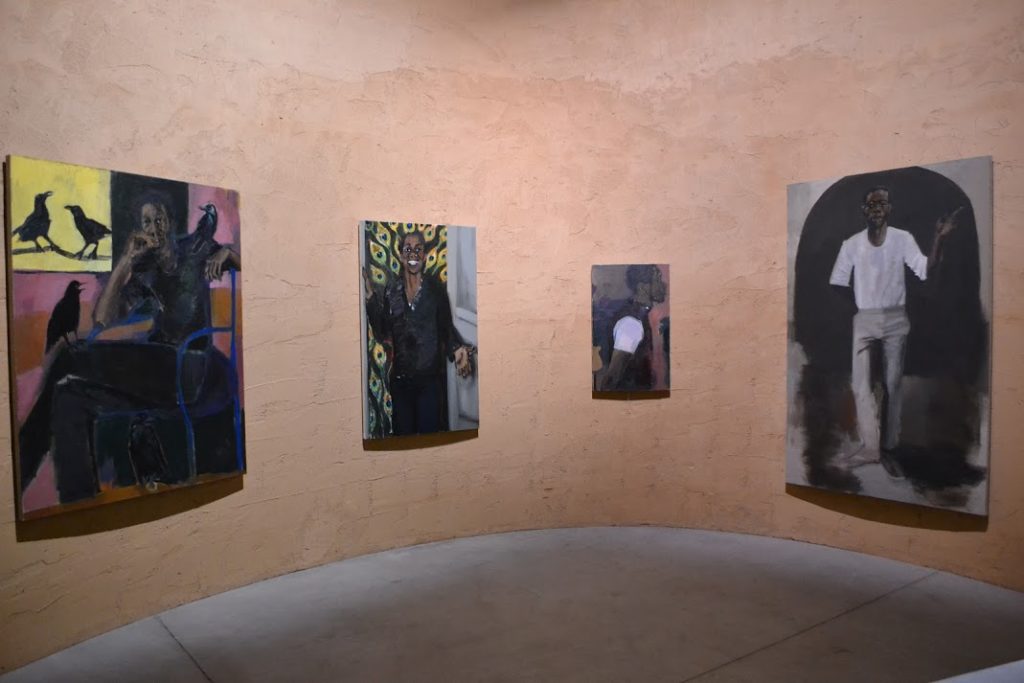
Paintings by Lynette Yiadom-Boakye in Ghana’s pavilion, designed by David Adjaye, at the Venice Biennale.
Alex Da Corte reprises his captivating five-hour video installation Rubber Pencil Devil (2018), a standout work of the 2018 Carnegie International, in which he dons costumes from Mr. Rogers to Eminem, inhabiting cultural tropes and savoring them. The South African photographer Zanele Muholi paints her skin a darker shade of black and poses in a variety of guises in large images hung throughout the Arsenale.
One wishes that the late Felicia Abban, Ghana’s first professional photographer, would have been able to see Muholi’s work. On display in the Ghana Pavilion—the first for the country in a Venice Biennale—her self-portraits in different outfits are similarly, gloriously charming. They appear alongside the all-star team of John Akomfrah, El Anatsui, Ibrahim Mahama, Lynette Yiadom-Boakye, and Selasi Awusi Sosu. My only complaint: the clever structure of interlocking curved walls designed by architect David Adjaye is not big enough to give all the work ample space. Regardless, the pavilion is one of this year’s best—and proves a moving tribute to Okwui Enwezor, the project’s adviser, who died in March.
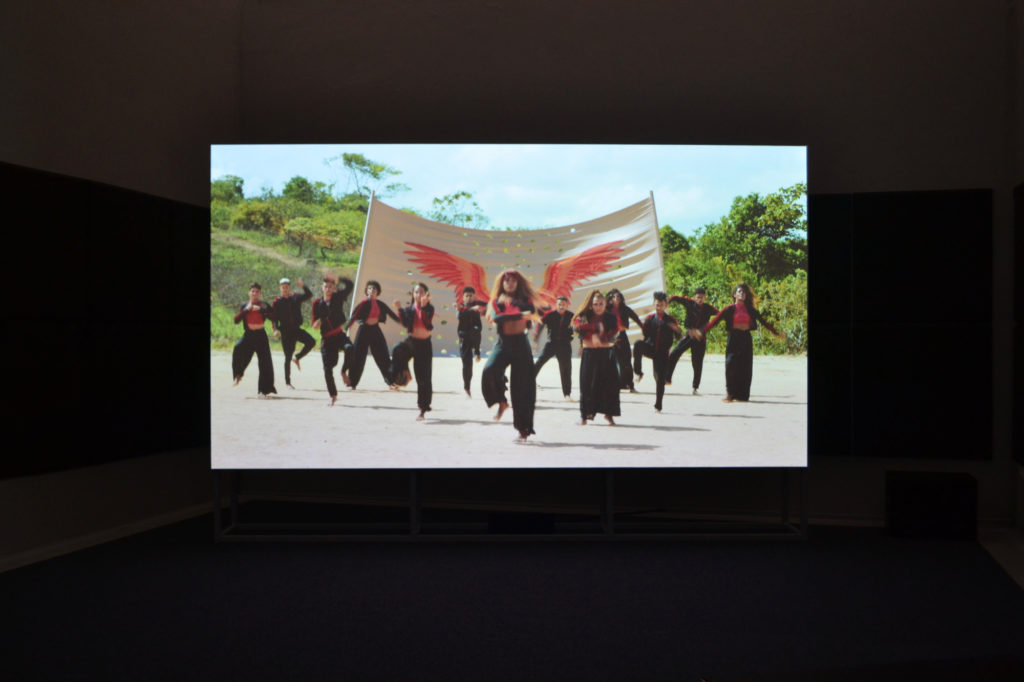
Bárbara Wagner & Benjamin de Burca’s rollicking video installation Swinguerra at the Brazilian Pavilion.
Also remarkable is Brazil’s pavilion, for which Bárbara Wagner and Benjamin de Burca assembled an irresistible two-channel music video—part documentary, part scripted —in collaboration with dance groups that specialize in brega, batidão do maloca, and swingueira. At one point, the dancers, many of whom are gender non-binary, cry: “Pleasure!” That could be a rallying cry for some of the most memorable work in this Biennale, which shows artists joyfully improvising and teasing out the political potency of play.
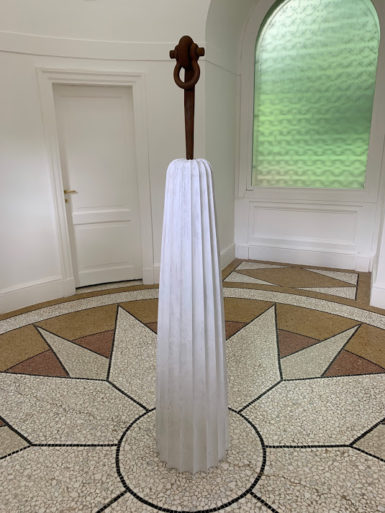
Martin Puryear, A Column for Sally Hemings, 2019, in the U.S. pavilion in the Giardini.
In Singapore’s pavilion Song-Ming Ang screens an uproarious and quite touching video of children performing a recorder piece of their own creation, and in the main show, Tarek Atoui has produced a constellation of handmade instruments that enchant as they buzz and whir and murmur. Atoui’s work is provisional and a little precarious, a bit like Nairy Baghramian’s ingenious, awkwardly shaped, vaguely corporeal forms in the Central Pavilion.
And then there is the inimitable Martin Puryear, who has staged a restrained, stunning exhibition in the U.S. Pavilion titled “Liberty/Libertà” that features eight immaculate wood sculptures. A tall lattice façade stands in front of the building, which was inspired by Thomas Jefferson’s Monticello. It’s made with lines that slope up to a circular form, from which a frightening swirl of dark wood emerges. Inside the building is a large red Phyrigan cap—a symbol of emancipation. In the small central room, A Column for Sally Hemings (2019) is named for the slave of Jefferson who was the mother to five of his children. The memorial of sorts is a spare, disquieting sculpture of two pieces joined together: a dark cast-iron shackle atop a poplar Doric column painted white.
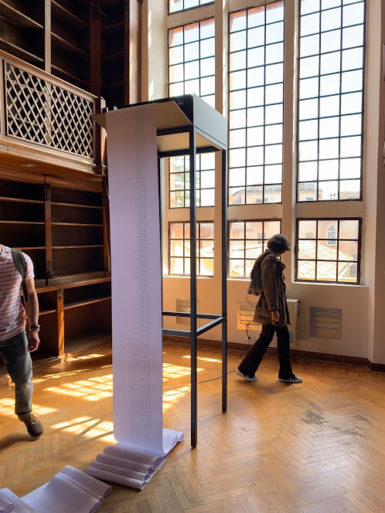
Installation view of “Dane Mitchell: Post Hoc” in the New Zealand pavilion of the Venice Biennale, with a printer steadily bringing out things that have disappeared or gone extinct.
With 90 national pavilions, a sprawling main show, dozens of other exhibitions, and so many other events and performances in Venice, it is ultimately impossible to make any grand single pronouncement or identify an overarching message for it all, but if there is one feeling that pervades the Biennale this year, it is a sense of loss, of things disappearing.
For the New Zealand Pavilion, Dane Mitchell has assembled a list of millions of objects, sights, and sensations that no longer exist or are on their way out, and he is having a computer read them, item by item, with its voice transmitted to speakers hidden around Venice and the words printed onto paper in an empty library. “The sound of ancient Hebrew being spoken,” I heard. Also: “The sound of a manual credit card imprinter.”
At the Fondazione Prada, a beautiful, melancholy retrospective of Jannis Kounellis has worn shoes lining the floor and a jacket and a hat hung on a coat stand that will never be picked up. At a narrow 16th-century church, the Vanhaerents Art Collection is showing The Death of James Lee Byars (1994), a large room covered with gold leaf, bearing an empty funeral bier, that Byars himself made while he was dying of cancer.
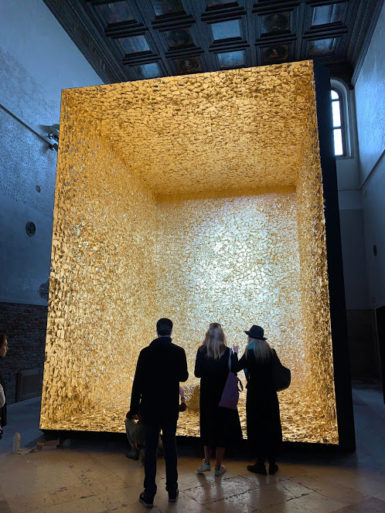
James Lee Byars, The Death of James Lee Byars, 1994, at the Chiesa di Santa Maria della Visitazione, presented by Vanhaerents Art Collection as a collateral event of the Venice Biennale.
Life is wasting away. Robotic people repetitiously go about their business—a chef rolls dough, a woman rocks in a rocking chair—in the mordant and darkly funny Belgian Pavilion conceived by Jos de Gruyter and Harald Thys. And the British Pavilion by Cathy Wilkes is desolate, filled with barely-there sculptures of people, some porcelain dishes on the wall, and an oddly familiar scent. It feels like walking through an abandoned house you once knew well and stumbling over only partially remembered events.
The island nation of Kiribati has devoted its pavilion to work focused on the grim fact that it may cease to exist because of climate change, and Naiza Khan, representing Pakistan for its first time in the Biennale, does the same for Manora Island, in elegant brass sculptures based on maps of flooded land.
A United Nations report released earlier this week stating that one million species are at risk of extinction probably contributed to my read of the art in Venice. It certainly made it all the more melancholy to be at a gargantuan centuries-old church late one night and watch Joan Jonas perform a piece about the oceans, reading from a scroll a long list of fish next to a screen with heartbreaking, luscious underwater footage.

Joan Jonas, Moving Off the Land, 2019, Ocean Space, Chiesa di San Lorenzo, Venice. Performance with Ikue Mori and Francesco Migliaccio. Commissioned by TBA21–Academy.
PHOTO MOIRA RICCA / © JOAN JONAS
Inside that airy room, part of a new initiative called Ocean Space, Jonas was pure magic, donning paper costumes, painting fish with a long brush, and dancing about in front of clips of starfish and jellyfish. She seemed to be searching for a way to make art fulfill a recuperative function, to not only memorialize a loss but to create something out of it. It is an art about refusing to surrender.
I had a similar sensation viewing works by Anicka Yi in Rugoff’s show—ambitious systems made with unusual, unpredictable materials, including algae. In the Arsenale, Yi is showing bulbous lanterns that hold flickering animatronic moths. They’re positioned above pools of liquid, and they look alive. Everything is in eerie balance, but you sense that things could go wrong at any second.

Performance still of Sun & Sea (Marina) by Lina Lapelytė, Vaiva Grainytė, and Rugilė Barzdžiukaite in the Lithuanian Pavilion, May 9, 2019.
Such bitter knowledge is captured uncannily in Sun & Sea (Marina), a rich operatic production by Lina Lapelytė, Vaiva Grainytė, and Rugilė Barzdžiukaitė in the Lithuanian Pavilion, which is the Biennale’s surprise hit. The team has constructed a beach on the first floor of an old warehouse in the Arsenale, and one watches a dozen or so singers, who are reclining on beach blankets, from the second floor. They are focused on their vacations, but reality keeps intruding. “This year the sea is as green as a forest,” the chorus intones near the conclusion, with a touch of noble sorrow. “Eutrophication! / Botanical gardens are flourishing in the sea— /The water blooms. / Our bodies are covered with a slippery green fleece / Our swimsuits are filling up with algae.”
It’s a depiction of awe in the face of oncoming destruction: a sentiment very resonant for 2019. But it is also a vision of a new community forming, of people banding together and waking up. What other option is there? The storms, we know, are going to get worse.
[ad_2]
Source link

